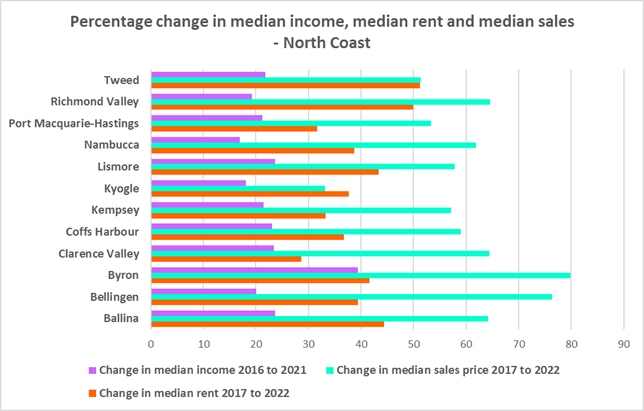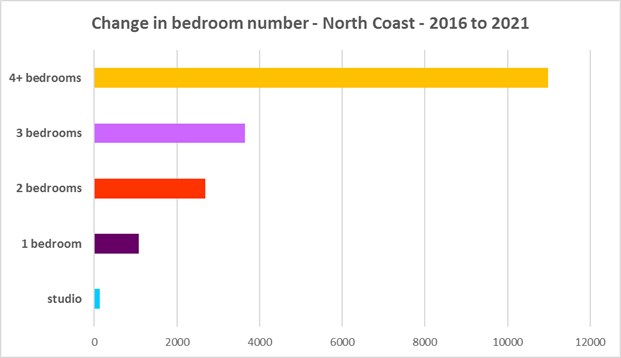Housing Market Snapshot - North Coast Region
The Housing Story in the North Coast
Located between Foster/Tuncurry and the Queensland border and inland to Dorrigo and the Richmond Ranges, with significant areas of national and Marine Park, forest, conservation areas, beaches and rivers, this region is comprised of twelve local government areas – Ballina, Bellingen, Byron Bay, Clarence Valley, Coffs Harbour, Kempsey, Kyogle, Lismore, Nambucca Valley, Port Macquarie-Hastings, Richmond Valley and Tweed. Population growth has been strong, with a significant influx of sea changers increasing the demand for housing and impacting the housing market. Floods and bushfires have affected the region, causing housing shortages.
Infrastructure Australia’s report “2022 Regional Strengths and Infrastructure Gaps” splits the region between Mid North Coast and Northern Rivers. The report notes that the Mid North Coast has developed as a hub for tourism, education, health, and small businesses, and nominated Healthcare and social assistance, Agriculture, forestry and fishing as well as the Knowledge sector as the key regional growth industries. For the Northern Rivers region, the report notes that the region has diversified its agricultural produce, built a thriving agricultural industry along with the creative and digital content industry, promoting the region as a preferred location for productions. In addition the report nominates Agriculture, forestry and fishing, Tourism and the Knowledge sector as key regional growth industries and notes that the NSW Government planned Casino Industries Activation project is expected to drive economic growth in the region.
What’s the Housing Demand?
Between 2016 and 2021, the population of the North Coast grew by 7.7%. In numeric terms, the largest population increase occurred in Port-Macquarie Hastings with 8,221, followed by Tweed with 6,018 and Coffs Harbour with 5,810. Note that Byron LGA ranks sixth in the whole of NSW for percentage population growth between 2016 and 2021 with 14.5%.
The median age of the population of the twelve LGAs comprising the North Coast region at the 2021 Census ranges between 43 years (Byron) and 52 (Kyogle and Nambucca Valley). All North Coast LGAs have a median age at or above the median age for the Rest of NSW of 43 years. Not surprisingly, there is a strong similarity in the age profile of the North Coast LGAs. All have a higher proportion of residents aged over 55. The higher median age and higher proportions of older age cohorts indicates that there is a need for housing to suit older residents, in particular.
On the North Coast, couple families without children are the most common household type, followed by lone person households, with both single parent household and other household types being more prevalent than in the Rest of NSW. In the Rest of NSW, couple families with children households are the largest household type. This mix of household types suggests the need for a variety of housing, ensuring housing choice, including studio, one and two bedroom homes to suit smaller households.
At the 2021 Census, low income households comprise the largest proportion of all households in every North Coast region LGA, with the exception of Ballina. Between 2016 and 2021 the number of low income households in the North Coast increased by 14.6%, while moderate income households increased by 4.8% and high income households declined marginally by -0.1%.
What’s happening in the Market?
There have been strong increases in median rents in the North Coast. Between September 2017 and September 2022, increases in rents ranged between 28.6% in Clarence Valley and 51.2% in Tweed. Vacancy rates in the region are tight and have been for some time, indicating a chronic undersupply of rental housing.
The SGS Economics and Planning November 2022 Rental Affordability Index report notes that the greatest decline in rental affordability over the past two years is evident in the coastal areas of regional NSW (e.g., Tweed Heads, Woolgoolga, Port Macquarie). Further, the impact of the floods has been significant – for example Lismore saw a -10% decline in affordability and Bellingen -14% between 2021 and 2022. At the same time, the North Coast sub-region and Byron Shire in particular has experienced significant impacts from the growth of short term rentals, including loss of long term and affordable rental housing.
All North Coast region LGAs experienced a significant loss of affordable private rental housing stock between 2017 and 2022, averaging -43.5% fewer affordable private rental bonds lodged in 2022 than in 2017.
The proportion of both very low and low income renters in housing stress increased between 2016 and 2021 in the North Coast, with a total of 93.9% of very low and 77.4% of low income households in rental stress at 2021 – well above the averages for the Rest of NSW.
Purchase affordability for very low income households has been extremely low for a long time across much of NSW, including the North Coast. However, historically there were pockets of the North Coast that were more affordable – for example, Kyogle and Kempsey. That is no longer the case. It is increasingly difficult for lower income households to affordably purchase here. In 2021 45.5% of very low and low income purchasers were in housing stress in the North Coast – a higher proportion than the average for the Rest of NSW
What’s Happening with Supply – and is it a good match?
At the 2021 Census there were 231,764 dwellings in the North Coast region and of these there were a total of 3,242 households living in caravan, cabin/houseboat accommodation, well down from 4,406 in 2016. While people living in caravans are included in the homeless data in the Census, caravan or residential parks are one of the few remaining affordable housing options for lower income earners. The loss of this accommodation reduces options for lower income households and reduces flexibility, for example to accommodate seasonal workers. The significant decline in the number of these in most local government areas since the previous Census is another indicator of the loss of affordable housing.
The North Coast has little variation in the number of bedrooms per dwelling. Across the North Coast 41.4% of dwellings have three bedrooms and a further 31.2% have four or more bedrooms. Only 0.7% of homes are studios, 4.8% have one bedroom and 19.8% have two bedrooms. Given that lone person and couple only households comprised 48.5% of all households in the North Coast, the fact that studio and one bedroom homes combined comprise just 5.5% of the housing stock shows a mismatch between household type and dwelling size and a significant lack of housing choice for smaller households.
There have been declines in the proportion of studio dwellings (from 0.7%) and two bedroom homes (from 20.2%) and a small increase in one bedroom homes (from 4.7%) from the 2016 Census. This demonstrates that housing choice is worsening and indicates that the overwhelming majority of new home development has three, four or more bedrooms. This would be exacerbated by alterations and additions to existing housing stock (adding bedrooms to two and three bedroom homes). Particularly given the increase in smaller household types and older age cohorts over the same period, it is important to improve housing choice. Two bedroom dwellings in particular offer the most flexibility, given they are also suitable for small families and allow older residents to have family members or carers to stay while giving them a more manageable size home to maintain.
Change 2016 to 2021

Comparative Stats
- Population at 2021: 541,046
- Number of dwellings at 2021: 231,764
- Number of households at 2021: 225,688
- Number of Very Low and Low income households at 2021: 118,739
- Number of rental households at 2021: 55,769
- Number of Very Low and Low income rental households at 2016: 19,614
- Number of Very Low and Low Income Renters in Housing Stress at 2021: 16,375
- Reduction in new rental bonds lodged affordable to low income households (2017-2022): -829
- Number of rental bonds lodged affordable for low income households 2022: 1,077
- Number of Homeless at 2021: 2,459
- Number of Marginally Housed at 2021: 2,287
Key Regional Stats
- Number of lone person households: 60,209
- Number of couple only households: 63,909
- Number of studio dwellings: 1,518
- Number of one bedroom dwellings: 10,111
- Number of caravan, cabin, houseboat and improvised dwellings: 3,324
- Unoccupied private dwellings: 22,927

Additional information
Additional information on:
What’s happening with demand is at